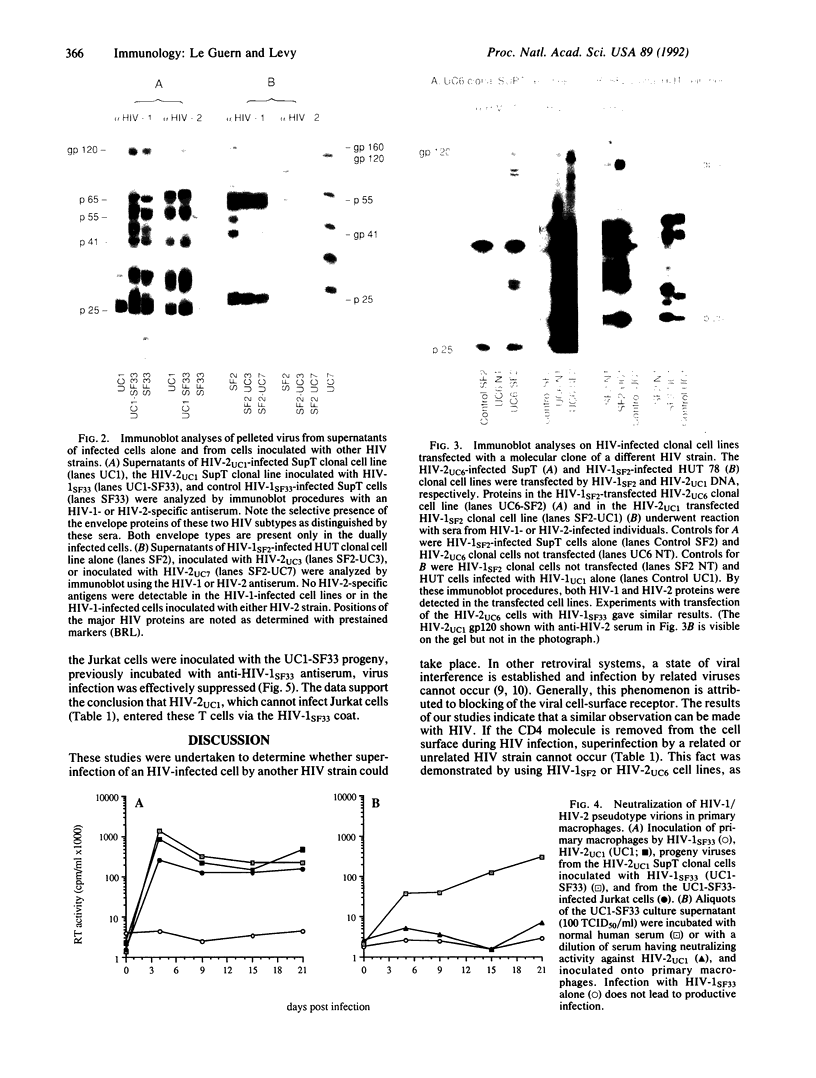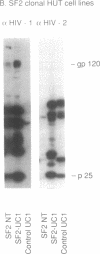Abstract
In studies on viral interference, cloned T-cell lines chronically infected with human immunodeficiency virus (HIV) type 1 or HIV-2 were inoculated with several strains of these two AIDS retrovirus subtypes. HIV-2UC1-infected cells, which still express the CD4 receptor, could be superinfected with a variety of HIV-1 and HIV-2 strains. This event was accompanied by cytopathic effects in the cells and production of pseudotype virions with an expanded cellular host range. HIV-1- or HIV-2-infected clonal cell lines, which did not express CD4, could not be superinfected by any HIV strains but were coinfected after transfection of molecular clones into the persistently infected cells. These observations indicate that viral interference with HIV occurs at the cell surface and involves a down-modulation of the CD4 molecule. If the CD4 protein is expressed, superinfection can take place, and phenotypically mixed virus particles are produced. Since HIV-1 and HIV-2 dually infected individuals have been detected, these in vitro observations may have relevance to the in vivo state.
Full text
PDF




Images in this article
Selected References
These references are in PubMed. This may not be the complete list of references from this article.
- Asjö B., Morfeldt-Månson L., Albert J., Biberfeld G., Karlsson A., Lidman K., Fenyö E. M. Replicative capacity of human immunodeficiency virus from patients with varying severity of HIV infection. Lancet. 1986 Sep 20;2(8508):660–662. [PubMed] [Google Scholar]
- Castro B. A., Barnett S. W., Evans L. A., Moreau J., Odehouri K., Levy J. A. Biologic heterogeneity of human immunodeficiency virus type 2 (HIV-2) strains. Virology. 1990 Oct;178(2):527–534. doi: 10.1016/0042-6822(90)90350-z. [DOI] [PubMed] [Google Scholar]
- Castro B. A., Cheng-Mayer C., Evans L. A., Levy J. A. HIV heterogeneity and viral pathogenesis. AIDS. 1988;2 (Suppl 1):S17–S27. doi: 10.1097/00002030-198800001-00004. [DOI] [PubMed] [Google Scholar]
- Cheng-Mayer C., Quiroga M., Tung J. W., Dina D., Levy J. A. Viral determinants of human immunodeficiency virus type 1 T-cell or macrophage tropism, cytopathogenicity, and CD4 antigen modulation. J Virol. 1990 Sep;64(9):4390–4398. doi: 10.1128/jvi.64.9.4390-4398.1990. [DOI] [PMC free article] [PubMed] [Google Scholar]
- Cheng-Mayer C., Rutka J. T., Rosenblum M. L., McHugh T., Stites D. P., Levy J. A. Human immunodeficiency virus can productively infect cultured human glial cells. Proc Natl Acad Sci U S A. 1987 May;84(10):3526–3530. doi: 10.1073/pnas.84.10.3526. [DOI] [PMC free article] [PubMed] [Google Scholar]
- Evans L. A., McHugh T. M., Stites D. P., Levy J. A. Differential ability of human immunodeficiency virus isolates to productively infect human cells. J Immunol. 1987 May 15;138(10):3415–3418. [PubMed] [Google Scholar]
- Evans L. A., Moreau J., Odehouri K., Legg H., Barboza A., Cheng-Mayer C., Levy J. A. Characterization of a noncytopathic HIV-2 strain with unusual effects on CD4 expression. Science. 1988 Jun 10;240(4858):1522–1525. doi: 10.1126/science.2836951. [DOI] [PubMed] [Google Scholar]
- Evans L. A., Moreau J., Odehouri K., Seto D., Thomson-Honnebier G., Legg H., Barboza A., Cheng-Mayer C., Levy J. A. Simultaneous isolation of HIV-1 and HIV-2 from an AIDS patient. Lancet. 1988 Dec 17;2(8625):1389–1391. doi: 10.1016/s0140-6736(88)90586-7. [DOI] [PubMed] [Google Scholar]
- Fenyö E. M., Morfeldt-Månson L., Chiodi F., Lind B., von Gegerfelt A., Albert J., Olausson E., Asjö B. Distinct replicative and cytopathic characteristics of human immunodeficiency virus isolates. J Virol. 1988 Nov;62(11):4414–4419. doi: 10.1128/jvi.62.11.4414-4419.1988. [DOI] [PMC free article] [PubMed] [Google Scholar]
- Hart A. R., Cloyd M. W. Interference patterns of human immunodeficiency viruses HIV-1 and HIV-2. Virology. 1990 Jul;177(1):1–10. doi: 10.1016/0042-6822(90)90454-y. [DOI] [PubMed] [Google Scholar]
- Hoffman A. D., Banapour B., Levy J. A. Characterization of the AIDS-associated retrovirus reverse transcriptase and optimal conditions for its detection in virions. Virology. 1985 Dec;147(2):326–335. doi: 10.1016/0042-6822(85)90135-7. [DOI] [PubMed] [Google Scholar]
- Homsy J., Meyer M., Tateno M., Clarkson S., Levy J. A. The Fc and not CD4 receptor mediates antibody enhancement of HIV infection in human cells. Science. 1989 Jun 16;244(4910):1357–1360. doi: 10.1126/science.2786647. [DOI] [PubMed] [Google Scholar]
- Hoxie J. A., Matthews D. M., Callahan K. J., Cassel D. L., Cooper R. A. Transient modulation and internalization of T4 antigen induced by phorbol esters. J Immunol. 1986 Aug 15;137(4):1194–1201. [PubMed] [Google Scholar]
- Ishizaki R., Shimizu T. Observations on the envelope properties of RSV(O). Virology. 1970 Feb;40(2):415–417. doi: 10.1016/0042-6822(70)90423-x. [DOI] [PubMed] [Google Scholar]
- Kaminsky L. S., McHugh T., Stites D., Volberding P., Henle G., Henle W., Levy J. A. High prevalence of antibodies to acquired immune deficiency syndrome (AIDS)-associated retrovirus (ARV) in AIDS and related conditions but not in other disease states. Proc Natl Acad Sci U S A. 1985 Aug;82(16):5535–5539. doi: 10.1073/pnas.82.16.5535. [DOI] [PMC free article] [PubMed] [Google Scholar]
- Klatzmann D., Champagne E., Chamaret S., Gruest J., Guetard D., Hercend T., Gluckman J. C., Montagnier L. T-lymphocyte T4 molecule behaves as the receptor for human retrovirus LAV. Nature. 1984 Dec 20;312(5996):767–768. doi: 10.1038/312767a0. [DOI] [PubMed] [Google Scholar]
- Levy J. A., Tobler L. H., McHugh T. M., Casavant C. H., Stites D. P. Long-term cultivation of T-cell subsets from patients with acquired immune deficiency syndrome. Clin Immunol Immunopathol. 1985 Jun;35(3):328–336. doi: 10.1016/0090-1229(85)90093-5. [DOI] [PubMed] [Google Scholar]
- Pan L. Z., Cheng-Mayer C., Levy J. A. Patterns of antibody response in individuals infected with the human immunodeficiency virus. J Infect Dis. 1987 Apr;155(4):626–632. doi: 10.1093/infdis/155.4.626. [DOI] [PubMed] [Google Scholar]
- Psallidopoulos M. C., Schnittman S. M., Thompson L. M., 3rd, Baseler M., Fauci A. S., Lane H. C., Salzman N. P. Integrated proviral human immunodeficiency virus type 1 is present in CD4+ peripheral blood lymphocytes in healthy seropositive individuals. J Virol. 1989 Nov;63(11):4626–4631. doi: 10.1128/jvi.63.11.4626-4631.1989. [DOI] [PMC free article] [PubMed] [Google Scholar]
- Rubin H. A VIRUS IN CHICK EMBRYOS WHICH INDUCES RESISTANCE IN VITRO TO INFECTION WITH ROUS SARCOMA VIRUS. Proc Natl Acad Sci U S A. 1960 Aug;46(8):1105–1119. doi: 10.1073/pnas.46.8.1105. [DOI] [PMC free article] [PubMed] [Google Scholar]
- Stevenson M., Meier C., Mann A. M., Chapman N., Wasiak A. Envelope glycoprotein of HIV induces interference and cytolysis resistance in CD4+ cells: mechanism for persistence in AIDS. Cell. 1988 May 6;53(3):483–496. doi: 10.1016/0092-8674(88)90168-7. [DOI] [PMC free article] [PubMed] [Google Scholar]
- Tang S. B., Levy J. A. Inactivation of HIV-1 by trypsin and its use in demonstrating specific virus infection of cells. J Virol Methods. 1991 Jun;33(1-2):39–46. doi: 10.1016/0166-0934(91)90005-k. [DOI] [PubMed] [Google Scholar]
- Tateno M., Levy J. A. MT-4 plaque formation can distinguish cytopathic subtypes of the human immunodeficiency virus (HIV). Virology. 1988 Nov;167(1):299–301. doi: 10.1016/0042-6822(88)90084-0. [DOI] [PubMed] [Google Scholar]
- Tersmette M., de Goede R. E., Al B. J., Winkel I. N., Gruters R. A., Cuypers H. T., Huisman H. G., Miedema F. Differential syncytium-inducing capacity of human immunodeficiency virus isolates: frequent detection of syncytium-inducing isolates in patients with acquired immunodeficiency syndrome (AIDS) and AIDS-related complex. J Virol. 1988 Jun;62(6):2026–2032. doi: 10.1128/jvi.62.6.2026-2032.1988. [DOI] [PMC free article] [PubMed] [Google Scholar]
- Walker C. M., Moody D. J., Stites D. P., Levy J. A. CD8+ T lymphocyte control of HIV replication in cultured CD4+ cells varies among infected individuals. Cell Immunol. 1989 Apr 1;119(2):470–475. doi: 10.1016/0008-8749(89)90259-1. [DOI] [PubMed] [Google Scholar]
- Weller S. K., Joy A. E., Temin H. M. Correlation between cell killing and massive second-round superinfection by members of some subgroups of avian leukosis virus. J Virol. 1980 Jan;33(1):494–506. doi: 10.1128/jvi.33.1.494-506.1980. [DOI] [PMC free article] [PubMed] [Google Scholar]








